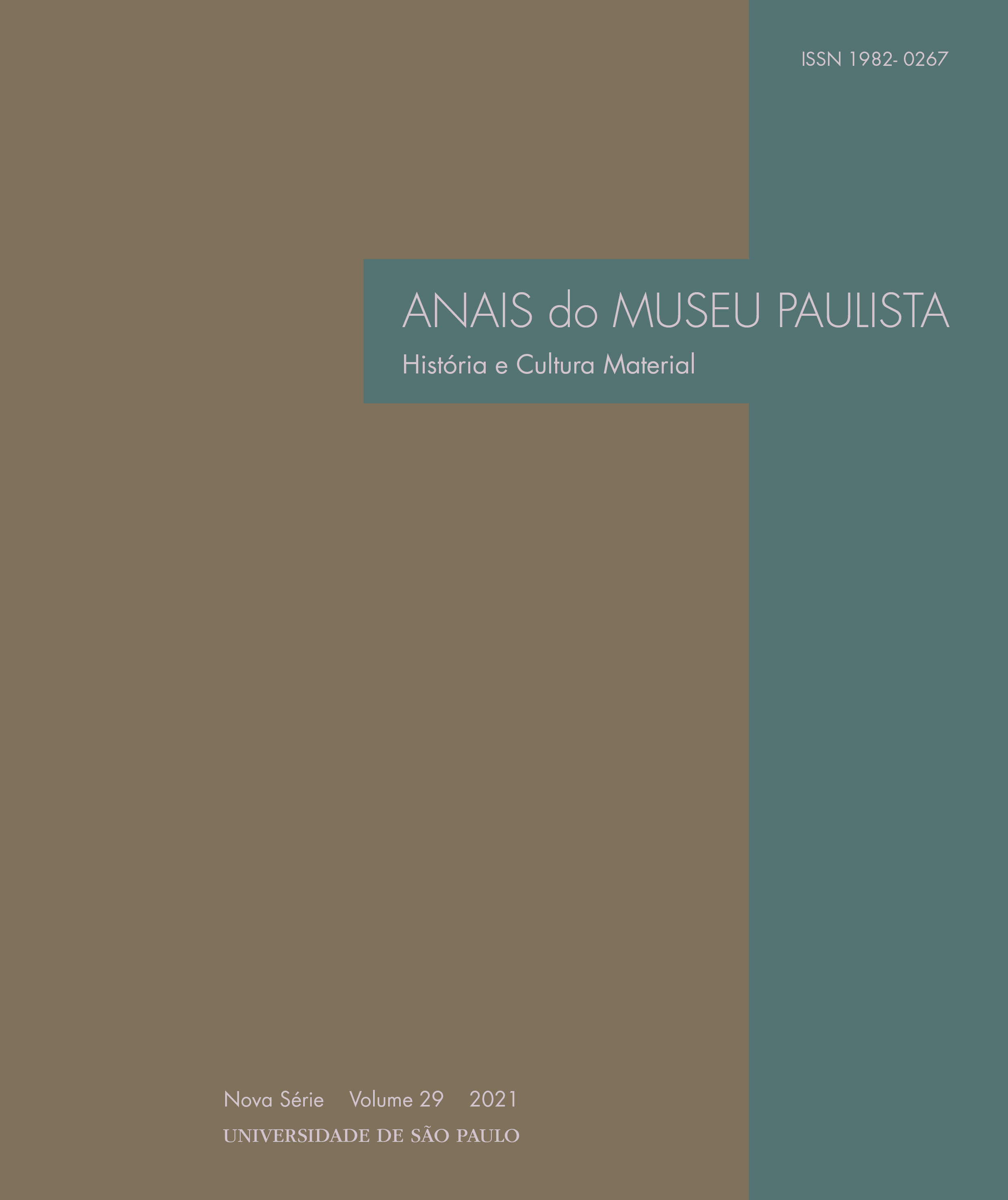Kimono: elucidating meanings of Japanese textile artifacts for a museum audience
DOI:
https://doi.org/10.1590/1982-02672021v29e9Palavras-chave:
Têxteis japoneses, Cultura material, Semiótica, Curadoria de têxteis, Programação de museus, QuimonoResumo
O objetivo desta pesquisa foi criar textos de museus e materiais educacionais para a seção têxtil de uma grande exposição de um museu universitário de um ano, focada em explorar a cultura e a estética japonesas por meio de obras de arte aplicada e fina. Poucas informações sobre os têxteis estavam disponíveis. Uma amostra do histórico quimono japonês, yukata e obi, em uma coleção universitária foi examinada usando métodos de pesquisa em cultura material e semiótica. Os motivos presentes nos têxteis foram identificados e explorados pela forma como eles representam valores relevantes para as práticas culturais japonesas ao longo do tempo. Em particular, os motivos foram explorados por sua atração notável pelos valores religiosos e
culturais de uma sociedade. Os motivos eram predominantemente botânicos, enfatizando o
respeito pela natureza na cultura japonesa. Outras categorias de motivos presentes incluem elementos geométricos, animais/insetos, objetos culturais/cotidianos e motivos de paisagem. Foram identificados 104 motivos individuais. Os significados simbólicos foram examinados e
interpretados juntamente com materiais, cores e técnicas atuais. O uso de métodos de pesquisa
em cultura e semiótica de materiais para análise de têxteis japoneses é mapeado neste estudo.
Downloads
Referências
REFERENCES
BOOKS, ARTICLES, AND THESES
APPADURAI, Arjun. The social life of things: commodities in cultural perspective. Cambridge: Cambridge University Press, 1986.
AREO, Margaret Olugbemisola; KALILU, Razaq Olatunde Rom. Origin of and visual semiotics in Yoruba textile adire. Arts and Design Studies, [s. l.], v. 12, p. 2.224-6.061, 2013.
ATTFIELD, Judy. Wild things: the material culture of everyday life. Oxford: Berg, 2000.
BAIRD, Merrily. Symbols of Japan: thematic motifs in art and design. New York: Rizzoli, 2001.
DALBY, Liza. C. Kimono: Fashioning Culture. Seattle: University of Washington Press, 2001.
DEELY, John. Basics of semiotics. Bloomington: Indiana University Press, 1990.
DOWER, John. The elements of Japanese design: a Handbook of family crests, heraldry & symbolism. New York: Weatherhill, 1971.
EASTOP, Dinah. Material culture in action: conserving garments deliberately concealed within buildings. Anais do Museu Paulista: História e Cultura Material, [S. l.], v. 15, n. 1, p. 187-204, 2007. DOI: 10.1590/S0101-47142007000100004. Available from: <https://bit.ly/2O7zQOr>. Access on: Feb. 26, 2021.
GUNTER, Susan. Japanese design motifs and their symbolism as used on itajime-dyed juban. Athens: University of Georgia, 1999
INGOLD, Timothy. Materials against materiality. Archaeological Dialogues, Cambridge, v. 14, n. 1, p. 1-16, 2007. ISSN 1478-2294.
JACKSON, Anna. Kimono: the art and evolution of Japanese fashion. London: Thames & Hudson, 2015.
KRUGER, Kathryn Sullivan. Weaving the word: the metaphorics of weaving and female textual
production. Selinsgrove: Susquehanna University Press, 2001. ISBN 9781575910529.
MILLER, Daniel. Stuff. Cambridge: Polity Press, 2010.
PROWN, Jules. Mind in matter: an introduction to material culture theory and method. Winterthur Portfolio, Chicago, v. 17, n. 1, p. 1-19, 1982.
TAYLOR, Lou. Doing the laundry? A reassessment of object-based dress history. Fashion Theory: The Journal of Dress, Body, and Culture, Abingdon, v. 2, n. 4, p. 337-358, 1998. ISSN 1362-704X.
TIBBS, Kristen Marie. “Semiotics of the Cloth”: Reading Medieval Norse Textile Traditions. Huntington: Marshall University, 2012.
WONG, Dorothy. Buddhist pilgrim-monks as agents of cultural and artistic transmission: the international buddhist art style in East Asia, Ca. 645-770. Kent Ridge: NUS Press, 2018.
YANG, Sunny; NARASIN, Rochelle. Textile art of Japan. [S. l.]: Shufonotomo, 1989.
SITES
COLUMBIA UNIVERSITY. Japan: History-Archaeology. Asia for Educators, New York, 2020. Available from: <https://bit.ly/30jzTtd>. Access on: Nov. 15, 2019.
IKI-YA.COM & IKIYA.JP. Spring Attacks. Japanese Traditional Patterns and Traditional Colors. Tokyo, [20-?]. Available from: <https://bit.ly/2DqSlIy>. Access on: Oct. 23, 2019.
INDIANAPOLIS MUSEUM OF ART. Seven Gods of Good Fortune. Indianapolis, 2020. Available from: <https://bit.ly/3fhZDMA>. Access on: Nov. 6, 2019.
MATSUYAMA, Hiroko. Japanese Patterns: traditional motifs and designs. Patterns, [s. l.], 2017. Available from: <https://bit.ly/2On9JAh>. Access on: Oct. 29, 2019.
MELISSA. Motifs. Ready, Set, Kimono!, [s. l.], 2016. Available from: <https://readysetkimono.com/motifs/>. Access on: Dec. 15, 2019.
PARENT, Mary Neighbour. Seigaiha. Jaanus, [s. l.], 2001. Available from: <https://bit.ly/38I7ssu>. Access on: Nov. 18, 2019.
RICHMAN-ABDOU, K. The unique history and fascinating evolution of the Japanese kimono. My Modern Met, [s. l.], Dec. 25, 2017. Available from: <https://bit.ly/2Zg81qi>. Access on: Dec. 13, 2019.
TACHIICHI. What is nani? Japanese Pattern, [s. l.], 2020. Available from: <https://bit.ly/3iLHBV8>. Access on: Nov. 17, 2019.
THE IMPERIAL HOUSEHOLD AGENCY. Exhibition Outlines: No.35 The Modern Era of Shippo – Japanese Cloisonné (2004/7/3 – 2004/9/5). Tokyo, 2004. Available from: <https://bit.ly/3fgyxFR>. Access on: Oct. 24, 2019.
IOWA STATE UNIVERSITY. Contemplate Japan. University Museums, Ames, 2020. Available at: <https://bit.ly/2GX6Kyd>. Access on: Oct. 14, 2020.
Downloads
Publicado
Edição
Seção
Licença
Copyright (c) 2021 Sophia Luu, Ellen McKinney

Este trabalho está licenciado sob uma licença Creative Commons Attribution 4.0 International License.
Autores que publicam nesta revista concordam com os seguintes termos:
- Autores mantém os direitos autorais e concedem à revista o direito de primeira publicação, com o trabalho simultaneamente licenciado sob a Licença Creative Commons Attribution que permite o compartilhamento do trabalho com reconhecimento da autoria e publicação inicial nesta revista.
- Autores têm autorização para assumir contratos adicionais separadamente, para distribuição não-exclusiva da versão do trabalho publicada nesta revista (ex.: publicar em repositório institucional ou como capítulo de livro), com reconhecimento de autoria e publicação inicial nesta revista.
- Autores têm permissão e são estimulados a publicar e distribuir seu trabalho online (ex.: em repositórios institucionais ou na sua página pessoal) a qualquer ponto antes ou durante o processo editorial, já que isso pode gerar alterações produtivas, bem como aumentar o impacto e a citação do trabalho publicado (Veja O Efeito do Acesso Livre).



